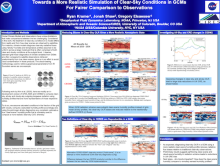Towards a more realistic simulation of clear-sky conditions for fairer comparison to observations
Ryan
Kramer
NOAA/GFDL
Poster
Global Climate Models and observations have unique limitations that make comparisons between the two challenging. Considered in this work, the treatment of clear-sky conditions in a model differs from reality and from how clear scenes are observed by satellites. For instance, climate models diagnose clear-sky radiative fluxes using “all-sky” humidity and temperature profiles assumed to be uniform across a large model grid that is often comprised of both clear and cloudy conditions at the subgrid level. Likewise, standard grid-mean diagnostics of climate variables from models are often compared to satellite observations retrieved predominantly from clear scenes, in an effort to avoid cloud contamination in those products. Here we modify GFDL’s atmospheric model to make simulations and diagnostics of clear-sky conditions more realistic and demonstrate that simple modifications to how humidity and temperature are computed in the climate model for clear-sky conditions, and felt by the radiation scheme interactively, leads to better agreement with observations on multiple fronts.

Poster file
kramer-ryan-confronting-poster.pdf
(1.32 MB)
